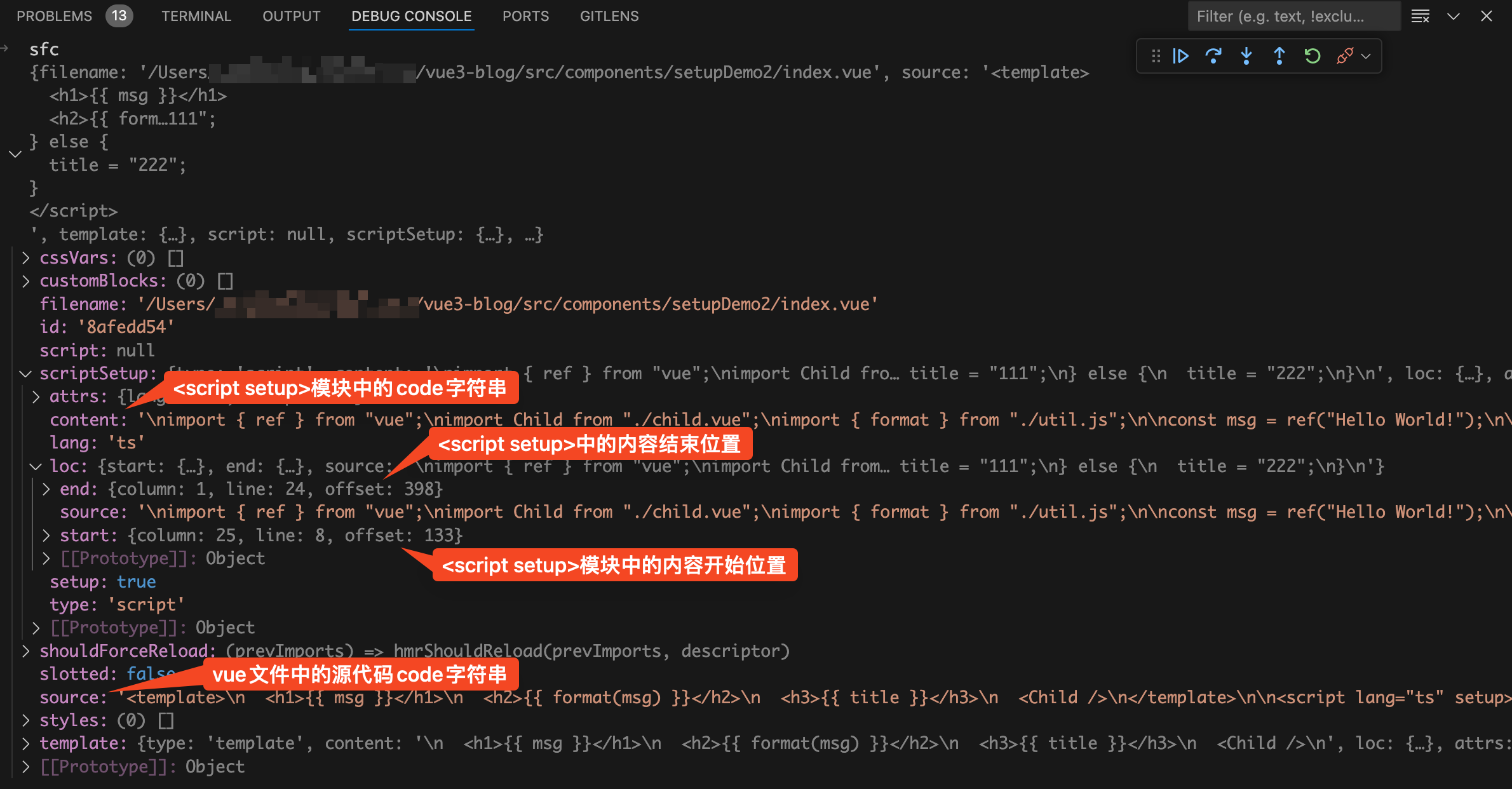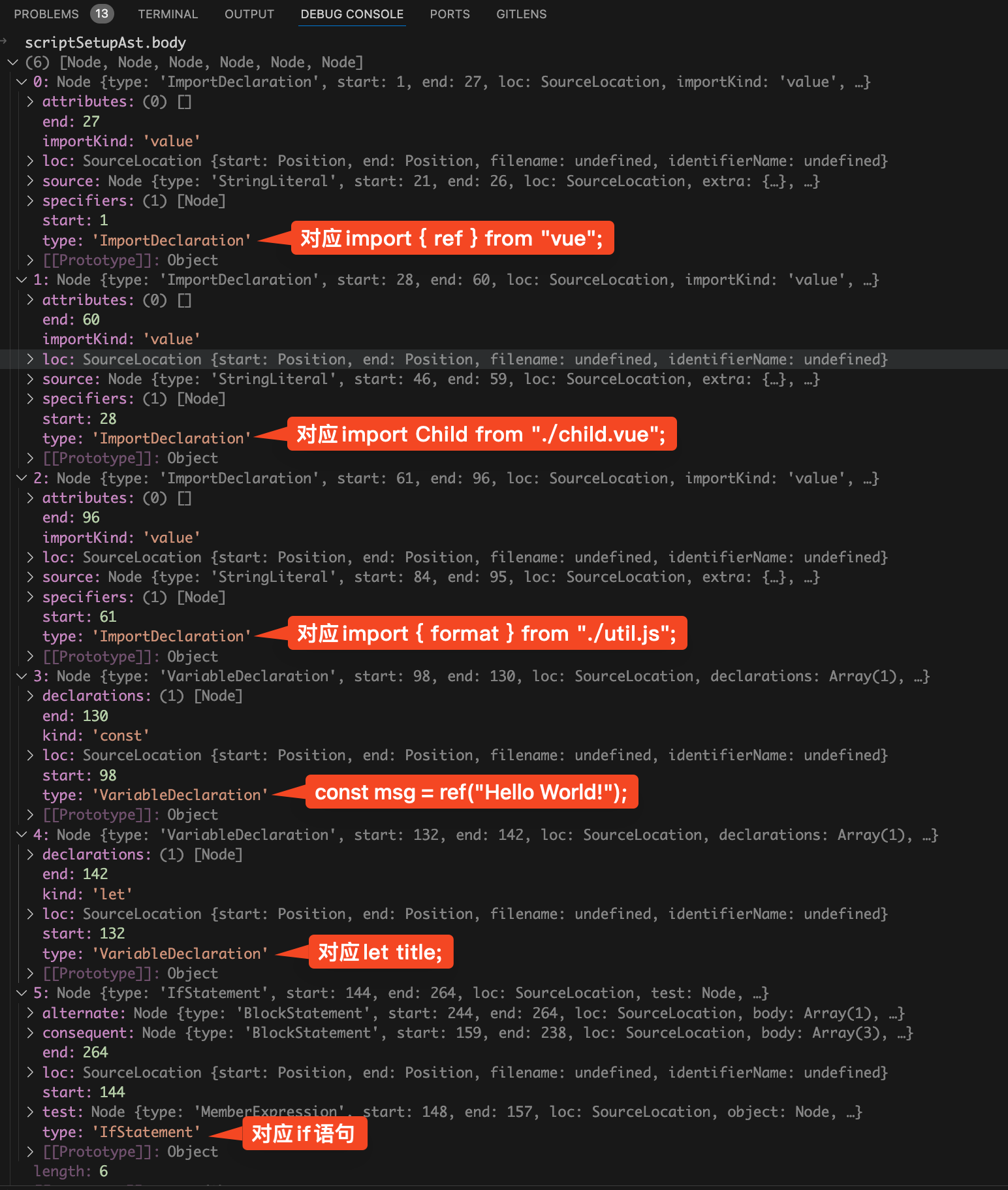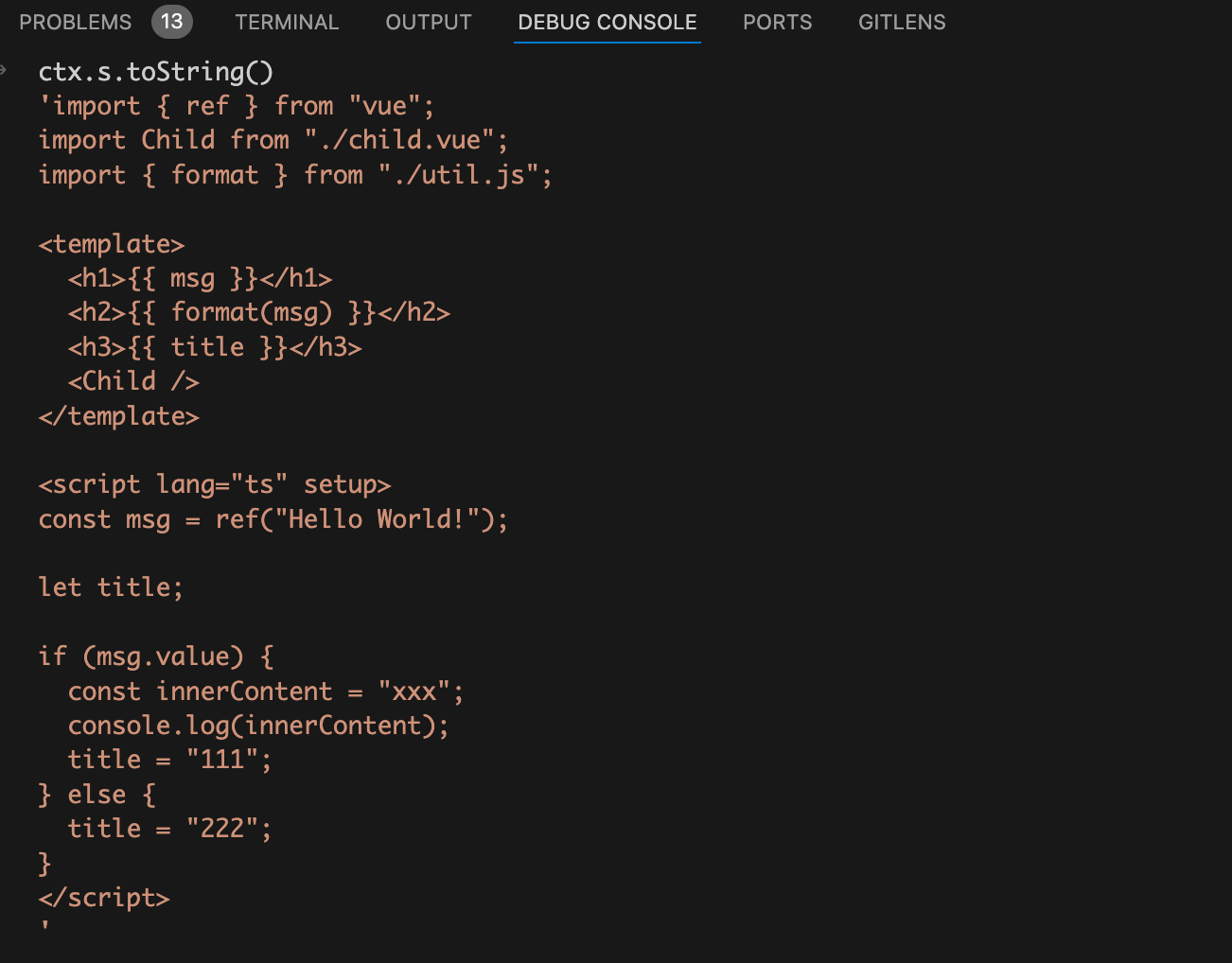有点东西,template可以直接使用setup语法糖中的变量原来是因为这个
前言
我们每天写vue3代码的时候都会使用到setup语法糖,那你知道为什么setup语法糖中的顶层绑定可以在template中直接使用的呢?setup语法糖是如何编译成setup函数的呢?本文将围绕这些问题带你揭开setup语法糖的神秘面纱。注:本文中使用的vue版本为3.4.19。
关注公众号:【前端欧阳】,给自己一个进阶vue的机会
看个demo
看个简单的demo,代码如下:
<template>
<h1>{{ msg }}</h1>
<h2>{{ format(msg) }}</h2>
<h3>{{ title }}</h3>
<Child />
</template>
<script lang="ts" setup>
import { ref } from "vue";
import Child from "./child.vue";
import { format } from "./util.js";
const msg = ref("Hello World!");
let title;
if (msg.value) {
const innerContent = "xxx";
console.log(innerContent);
title = "111";
} else {
title = "222";
}
</script>
在上面的demo中定义了四个顶层绑定:Child子组件、从util.js文件中导入的format方法、使用ref定义的msg只读常量、使用let定义的title变量。并且在template中直接使用了这四个顶层绑定。
由于innerContent是在if语句里面的变量,不是<script setup>中的顶层绑定,所以在template中是不能使用innerContent的。
但是你有没有想过为什么<script setup>中的顶层绑定就能在template中使用,而像innerContent这种非顶层绑定就不能在template中使用呢?
我们先来看看上面的代码编译后的样子,在之前的文章中已经讲过很多次如何在浏览器中查看编译后的vue文件,这篇文章就不赘述了。编译后的代码如下:
import { defineComponent as _defineComponent } from "/node_modules/.vite/deps/vue.js?v=23bfe016";
import { ref } from "/node_modules/.vite/deps/vue.js?v=23bfe016";
import Child from "/src/components/setupDemo2/child.vue";
import { format } from "/src/components/setupDemo2/util.js";
const _sfc_main = _defineComponent({
__name: "index",
setup(__props, { expose: __expose }) {
__expose();
const msg = ref("Hello World!");
let title;
if (msg.value) {
const innerContent = "xxx";
console.log(innerContent);
title = "111";
} else {
title = "222";
}
const __returned__ = {
msg,
get title() {
return title;
},
set title(v) {
title = v;
},
Child,
get format() {
return format;
},
};
return __returned__;
},
});
function _sfc_render(_ctx, _cache, $props, $setup, $data, $options) {
// ...省略
}
_sfc_main.render = _sfc_render;
export default _sfc_main;
从上面的代码中可以看到编译后已经没有了<script setup>,取而代之的是一个setup函数,这也就证明了为什么说setup是一个编译时语法糖。
setup函数的参数有两个,第一个参数为组件的 props。第二个参数为Setup 上下文对象,上下文对象暴露了其他一些在 setup 中可能会用到的值,比如:expose等。
再来看看setup函数中的内容,其实和我们的源代码差不多,只是多了一个return。使用return会将组件中的那四个顶层绑定暴露出去,所以在template中就可以直接使用<script setup>中的顶层绑定。
值的一提的是在return对象中title变量和format函数有点特别。title、format这两个都是属于访问器属性,其他两个msg、Child属于常见的数据属性。
title是一个访问器属性,同时拥有get 和 set,读取title变量时会走进get中,当给title变量赋值时会走进set中。
format也是一个访问器属性,他只拥有get ,调用format函数时会走进get中。由于他没有set,所以不能给format函数重新赋值。其实这个也很容易理解,因为format函数是从util.js文件中import导入的,当然不能给他重新赋值。
至于在template中是怎么拿到setup函数返回的对象可以看我的另外一篇文章: Vue 3 的 setup语法糖到底是什么东西?
看到这里有的小伙伴会有疑问了,不是还有一句import { ref } from "vue"也是顶层绑定,为什么里面的ref没有在setup函数中使用return暴露出去呢?还有在return对象中是如何将title、format识别为访问器属性呢?
在接下来的文章中我会逐一解答这些问题。
compileScript函数
在之前的 通过debug搞清楚.vue文件怎么变成.js文件文章中已经讲过了vue的script模块中的内容是由@vue/compiler-sfc包中的compileScript函数处理的,当然你没看过那篇文章也不会影响这篇文章的阅读。
首先我们需要启动一个debug终端。这里以vscode举例,打开终端然后点击终端中的+号旁边的下拉箭头,在下拉中点击Javascript Debug Terminal就可以启动一个debug终端。

然后在node_modules中找到vue/compiler-sfc包的compileScript函数打上断点,compileScript函数位置在/node_modules/@vue/compiler-sfc/dist/compiler-sfc.cjs.js。接下来我们先看看简化后的compileScript函数源码。
简化后的compileScript函数
在debug终端上面执行yarn dev后在浏览器中打开对应的页面,比如:http://localhost:5173/ 。此时断点就会走到compileScript函数中,在我们这个场景中简化后的compileScript函数代码如下:
function compileScript(sfc, options) {
// ---- 第一部分 ----
// 根据<script setup>中的内容生成一个ctx上下文对象
// 在ctx上下文对象中拥有一些属性和方法
const ctx = new ScriptCompileContext(sfc, options);
const { source, filename } = sfc;
// 顶层声明的变量、函数组成的对象
const setupBindings = Object.create(null);
// script标签中的内容开始位置和结束位置
const startOffset = ctx.startOffset;
const endOffset = ctx.endOffset;
// script setup中的内容编译成的AST抽象语法树
const scriptSetupAst = ctx.scriptSetupAst;
// ---- 第二部分 ----
// 遍历<script setup>中的内容,处理里面的import语句、顶层变量、函数、类、枚举声明还有宏函数
for (const node of scriptSetupAst.body) {
if (node.type === "ImportDeclaration") {
// ...省略
}
}
for (const node of scriptSetupAst.body) {
if (
(node.type === "VariableDeclaration" ||
node.type === "FunctionDeclaration" ||
node.type === "ClassDeclaration" ||
node.type === "TSEnumDeclaration") &&
!node.declare
) {
// 顶层声明的变量、函数、类、枚举声明组成的setupBindings对象
// 给setupBindings对象赋值,{msg: 'setup-ref'}
// 顶层声明的变量组成的setupBindings对象
walkDeclaration(
"scriptSetup",
node,
setupBindings,
vueImportAliases,
hoistStatic
);
}
}
// ---- 第三部分 ----
// 移除template中的内容和script的开始标签
ctx.s.remove(0, startOffset);
// 移除style中的内容和script的结束标签
ctx.s.remove(endOffset, source.length);
// ---- 第四部分 ----
// 将<script setup>中的顶层绑定的元数据存储到ctx.bindingMetadata对象中
// 为什么要多此一举存储一个bindingMetadata对象呢?答案是setup的return的对象有时会直接返回顶层变量,有时会返回变量的get方法,有时会返回变量的get和set方法,
// 所以才需要一个bindingMetadata对象来存储这些顶层绑定的元数据。
for (const [key, { isType, imported, source: source2 }] of Object.entries(
ctx.userImports
)) {
if (isType) continue;
ctx.bindingMetadata[key] =
imported === "*" ||
(imported === "default" && source2.endsWith(".vue")) ||
source2 === "vue"
? "setup-const"
: "setup-maybe-ref";
}
for (const key in setupBindings) {
ctx.bindingMetadata[key] = setupBindings[key];
}
// 生成setup方法的args参数;
let args = `__props`;
const destructureElements =
ctx.hasDefineExposeCall || !options.inlineTemplate
? [`expose: __expose`]
: [];
if (destructureElements.length) {
args += `, { ${destructureElements.join(", ")} }`;
}
// ---- 第五部分 ----
// 根据<script setup>中的顶层绑定生成return对象中的内容
let returned;
const allBindings = {
...setupBindings,
};
for (const key in ctx.userImports) {
// 不是引入ts中的类型并且import导入的变量还需要在template中使用
if (!ctx.userImports[key].isType && ctx.userImports[key].isUsedInTemplate) {
allBindings[key] = true;
}
}
returned = `{ `;
for (const key in allBindings) {
if (
allBindings[key] === true &&
ctx.userImports[key].source !== "vue" &&
!ctx.userImports[key].source.endsWith(".vue")
) {
returned += `get ${key}() { return ${key} }, `;
} else if (ctx.bindingMetadata[key] === "setup-let") {
const setArg = key === "v" ? `_v` : `v`;
returned += `get ${key}() { return ${key} }, set ${key}(${setArg}) { ${key} = ${setArg} }, `;
} else {
returned += `${key}, `;
}
}
returned = returned.replace(/, $/, "") + ` }`;
ctx.s.appendRight(
endOffset,
`
const __returned__ = ${returned}
Object.defineProperty(__returned__, '__isScriptSetup', { enumerable: false, value: true })
return __returned__
}
`
);
// ---- 第六部分 ----
// 生成setup函数
ctx.s.prependLeft(
startOffset,
`
${genDefaultAs} /*#__PURE__*/${ctx.helper(
`defineComponent`
)}({${def}${runtimeOptions}
${hasAwait ? `async ` : ``}setup(${args}) {
${exposeCall}`
);
ctx.s.appendRight(endOffset, `})`);
// ---- 第七部分 ----
// 插入import vue语句
if (ctx.helperImports.size > 0) {
ctx.s.prepend(
`import { ${[...ctx.helperImports]
.map((h) => `${h} as _${h}`)
.join(", ")} } from 'vue'
`
);
}
return {
// ...省略
bindings: ctx.bindingMetadata,
imports: ctx.userImports,
content: ctx.s.toString(),
};
}
首先我们来看看compileScript函数的第一个参数sfc对象,在之前的文章 vue文件是如何编译为js文件 中我们已经讲过了sfc是一个descriptor对象,descriptor对象是由vue文件编译来的。
descriptor对象拥有template属性、scriptSetup属性、style属性,分别对应vue文件的<template>模块、<script setup>模块、<style>模块。
在我们这个场景只关注scriptSetup属性,sfc.scriptSetup.content的值就是<script setup>模块中code代码字符串,
sfc.source的值就是vue文件中的源代码code字符串。sfc.scriptSetup.loc.start.offset为<script setup>中内容开始位置,sfc.scriptSetup.loc.end.offset为<script setup>中内容结束位置。详情查看下图:

我们再来看compileScript函数中的内容,在compileScript函数中包含了从<script setup>语法糖到setup函数的完整流程。乍一看可能比较难以理解,所以我将其分为七块。
根据
<script setup>中的内容生成一个ctx上下文对象。遍历
<script setup>中的内容,处理里面的import语句、顶层变量、顶层函数、顶层类、顶层枚举声明等。移除template和style中的内容,以及script的开始标签和结束标签。
将
<script setup>中的顶层绑定的元数据存储到ctx.bindingMetadata对象中。根据
<script setup>中的顶层绑定生成return对象。生成setup函数定义
插入import vue语句
在接下来的文章中我将逐个分析这七块的内容。
生成ctx上下文对象
我们来看第一块的代码,如下:
// 根据<script setup>中的内容生成一个ctx上下文对象
// 在ctx上下文对象中拥有一些属性和方法
const ctx = new ScriptCompileContext(sfc, options);
const { source, filename } = sfc;
// 顶层声明的变量、函数组成的对象
const setupBindings = Object.create(null);
// script标签中的内容开始位置和结束位置
const startOffset = ctx.startOffset;
const endOffset = ctx.endOffset;
// script setup中的内容编译成的AST抽象语法树
const scriptSetupAst = ctx.scriptSetupAst;
在这一块的代码中主要做了一件事,使用ScriptCompileContext构造函数new了一个ctx上下文对象。在之前的 为什么defineProps宏函数不需要从vue中import导入?文章中我们已经讲过了ScriptCompileContext构造函数里面的具体代码,这篇文章就不赘述了。
本文只会讲用到的ScriptCompileContext类中的startOffset、endOffset、scriptSetupAst、userImports、helperImports、bindingMetadata、s等属性。
startOffset、endOffset属性是在ScriptCompileContext类的constructor构造函数中赋值的。其实就是sfc.scriptSetup.loc.start.offset和sfc.scriptSetup.loc.end.offset,<script setup>中内容开始位置和<script setup>中内容结束位置,只是将这两个字段塞到ctx上下文中。scriptSetupAst是在ScriptCompileContext类的constructor构造函数中赋值的,他是<script setup>模块的代码转换成的AST抽象语法树。在ScriptCompileContext类的constructor构造函数中会调用@babel/parser包的parse函数,以<script setup>中的code代码字符串为参数生成AST抽象语法树。userImports在new一个ctx上下文对象时是一个空对象,用于存储import导入的顶层绑定内容。helperImports同样在new一个ctx上下文对象时是一个空对象,用于存储需要从vue中import导入的函数。bindingMetadata同样在new一个ctx上下文对象时是一个空对象,用于存储所有的import顶层绑定和变量顶层绑定的元数据。s属性是在ScriptCompileContext类的constructor构造函数中赋值的,以vue文件中的源代码code字符串为参数new了一个MagicString对象赋值给s属性。
magic-string是由svelte的作者写的一个库,用于处理字符串的JavaScript库。它可以让你在字符串中进行插入、删除、替换等操作,并且能够生成准确的sourcemap。
MagicString对象中拥有toString、remove、prependLeft、appendRight等方法。s.toString用于生成返回的字符串,我们来举几个例子看看这几个方法你就明白了。
s.remove( start, end )用于删除从开始到结束的字符串:
const s = new MagicString('hello word');
s.remove(0, 6);
s.toString(); // 'word'
s.prependLeft( index, content )用于在指定index的前面插入字符串:
const s = new MagicString('hello word');
s.prependLeft(5, 'xx');
s.toString(); // 'helloxx word'
s.appendRight( index, content )用于在指定index的后面插入字符串:
const s = new MagicString('hello word');
s.appendRight(5, 'xx');
s.toString(); // 'helloxx word'
除了上面说的那几个属性,在这里定义了一个setupBindings变量。初始值是一个空对象,用于存储顶层声明的变量、函数等。
遍历<script setup>body中的内容
将断点走到第二部分,代码如下:
for (const node of scriptSetupAst.body) {
if (node.type === "ImportDeclaration") {
// ...省略
}
}
for (const node of scriptSetupAst.body) {
if (
(node.type === "VariableDeclaration" ||
node.type === "FunctionDeclaration" ||
node.type === "ClassDeclaration" ||
node.type === "TSEnumDeclaration") &&
!node.declare
) {
// 顶层声明的变量、函数、类、枚举声明组成的setupBindings对象
// 给setupBindings对象赋值,{msg: 'setup-ref'}
// 顶层声明的变量组成的setupBindings对象
walkDeclaration(
"scriptSetup",
node,
setupBindings,
vueImportAliases,
hoistStatic
);
}
}
在这一部分的代码中使用for循环遍历了两次scriptSetupAst.body,scriptSetupAst.body为script中的代码对应的AST抽象语法树中body的内容,如下图:

从上图中可以看到scriptSetupAst.body数组有6项,分别对应的是script模块中的6块代码。
第一个for循环中使用if判断node.type === "ImportDeclaration",也就是判断是不是import语句。如果是import语句,那么import的内容肯定是顶层绑定,需要将import导入的内容存储到ctx.userImports对象中。注:后面会专门写一篇文章来讲如何收集所有的import导入。
通过这个for循环已经将所有的import导入收集到了ctx.userImports对象中了,在debug终端看看此时的ctx.userImports,如下图:

从上图中可以看到在ctx.userImports中收集了三个import导入,分别是Child组件、format函数、ref函数。
在里面有几个字段需要注意,isUsedInTemplate表示当前import导入的东西是不是在template中使用,如果为true那么就需要将这个import导入塞到return对象中。
isType表示当前import导入的是不是type类型,因为在ts中是可以使用import导入type类型,很明显type类型也不需要塞到return对象中。
我们再来看第二个for循环,同样也是遍历scriptSetupAst.body。如果当前是变量定义、函数定义、类定义、ts枚举定义,这四种类型都属于顶层绑定(除了import导入以外就只有这四种顶层绑定了)。需要调用walkDeclaration函数将这四种顶层绑定收集到setupBindings对象中。
从前面的scriptSetupAst.body图中可以看到if模块的type为IfStatement,明显不属于上面的这四种类型,所以不会执行walkDeclaration函数将里面的innerContent变量收集起来后面再塞到return对象中。这也就解释了为什么非顶层绑定不能在template中直接使用。
我们在debug终端来看看执行完第二个for循环后setupBindings对象是什么样的,如下图:

从上图中可以看到在setupBindings对象中收集msg和title这两个顶层变量。其中的setup-ref表示当前变量是一个ref定义的变量,setup-let表示当前变量是一个let定义的变量。
移除template模块和style模块
接着将断点走到第三部分,代码如下:
ctx.s.remove(0, startOffset);
ctx.s.remove(endOffset, source.length);
这块代码很简单,startOffset为<script setup>中的内容开始位置,endOffset为<script setup>中的内容结束位置,ctx.s.remove方法为删除字符串。
所以ctx.s.remove(0, startOffset)的作用是:移除template中的内容和script的开始标签。
ctx.s.remove(endOffset, source.length)的作用是:移除style中的内容和script的结束标签。
我们在debug终端看看执行这两个remove方法之前的code代码字符串是什么样的,如下图:

从上图中可以看到此时的code代码字符串和我们源代码差不多,唯一的区别就是那几个import导入已经被提取到script标签外面去了(这个是在前面第一个for循环处理import导入的时候处理的)。
将断点走到执行完这两个remove方法之后,在debug终端看看此时的code代码字符串,如下图:

从上图中可以看到执行这两个remove方法后template模块、style模块(虽然本文demo中没有写style模块)、script开始标签、script结束标签都已经被删除了。唯一剩下的就是script模块中的内容,还有之前提出去的那几个import导入。
将顶层绑定的元数据存储到ctx.bindingMetadata
接着将断点走到第四部分,代码如下:
for (const [key, { isType, imported, source: source2 }] of Object.entries(
ctx.userImports
)) {
if (isType) continue;
ctx.bindingMetadata[key] =
imported === "*" ||
(imported === "default" && source2.endsWith(".vue")) ||
source2 === "vue"
? "setup-const"
: "setup-maybe-ref";
}
for (const key in setupBindings) {
ctx.bindingMetadata[key] = setupBindings[key];
}
// 生成setup函数的args参数;
let args = `__props`;
const destructureElements =
ctx.hasDefineExposeCall || !options.inlineTemplate
? [`expose: __expose`]
: [];
if (destructureElements.length) {
args += `, { ${destructureElements.join(", ")} }`;
}
上面的代码主要分为三块,第一块为for循环遍历前面收集到的ctx.userImports对象。这个对象里面收集的是所有的import导入,将所有import导入塞到ctx.bindingMetadata对象中。
第二块也是for循环遍历前面收集的setupBindings对象,这个对象里面收集的是顶层声明的变量、函数、类、枚举,同样的将这些顶层绑定塞到ctx.bindingMetadata对象中。
为什么要多此一举存储一个ctx.bindingMetadata对象呢?
答案是setup的return的对象有时会直接返回顶层变量(比如demo中的msg常量)。有时只会返回变量的访问器属性 get(比如demo中的format函数)。有时会返回变量的访问器属性 get和set(比如demo中的title变量)。所以才需要一个ctx.bindingMetadata对象来存储这些顶层绑定的元数据。
将断点走到执行完这两个for循环的地方,在debug终端来看看此时收集的ctx.bindingMetadata对象是什么样的,如下图:

最后一块代码也很简单进行字符串拼接生成setup函数的参数,第一个参数为组件的props、第二个参数为expose方法组成的对象。如下图:

生成return对象
接着将断点走到第五部分,代码如下:
let returned;
const allBindings = {
...setupBindings,
};
for (const key in ctx.userImports) {
// 不是引入ts中的类型并且import导入的变量还需要在template中使用
if (!ctx.userImports[key].isType && ctx.userImports[key].isUsedInTemplate) {
allBindings[key] = true;
}
}
returned = `{ `;
for (const key in allBindings) {
if (
allBindings[key] === true &&
ctx.userImports[key].source !== "vue" &&
!ctx.userImports[key].source.endsWith(".vue")
) {
returned += `get ${key}() { return ${key} }, `;
} else if (ctx.bindingMetadata[key] === "setup-let") {
const setArg = key === "v" ? `_v` : `v`;
returned += `get ${key}() { return ${key} }, set ${key}(${setArg}) { ${key} = ${setArg} }, `;
} else {
returned += `${key}, `;
}
}
returned = returned.replace(/, $/, "") + ` }`;
ctx.s.appendRight(
endOffset,
`
const __returned__ = ${returned}
Object.defineProperty(__returned__, '__isScriptSetup', { enumerable: false, value: true })
return __returned__
}
`
);
这部分的代码看着很多,其实逻辑也非常清晰,我也将其分为三块。
在第一块中首先使用扩展运算符...setupBindings将setupBindings对象中的属性合并到allBindings对象中,因为setupBindings对象中存的顶层声明的变量、函数、类、枚举都需要被return出去。
然后遍历ctx.userImports对象,前面讲过了ctx.userImports对象中存的是所有的import导入(包括从vue中import导入ref函数)。在循环里面执行了if判断!ctx.userImports[key].isType && ctx.userImports[key].isUsedInTemplate,这个判断的意思是如果当前import导入的不是ts的type类型并且import导入的内容在template模版中使用了。才会去执行allBindings[key] = true,执行后就会将满足条件的import导入塞到allBindings对象中。
后面生成setup函数的return对象就是通过遍历这个allBindings对象实现的。这也就解释了为什么从vue中import导入的ref函数也是顶层绑定,为什么他没有被setup函数返回。因为只有在template中使用的import导入顶层绑定才会被setup函数返回。
将断点走到遍历ctx.userImports对象之后,在debug终端来看看此时的allBindings对象是什么样的,如下图:

从上图中可以看到此时的allBindings对象中存了四个需要return的顶层绑定。
接着就是执行for循环遍历allBindings对象生成return对象的字符串,这循环中有三个if判断条件。我们先来看第一个,代码如下:
if (
allBindings[key] === true &&
ctx.userImports[key].source !== "vue" &&
!ctx.userImports[key].source.endsWith(".vue")
) {
returned += `get ${key}() { return ${key} }, `;
}
if条件判断是:如果当前import导入不是从vue中,并且也不是import导入一个vue组件。那么就给return一个只拥有get的访问器属性,对应我们demo中的就是import { format } from "./util.js"中的format函数。
我们再来看第二个else if判断,代码如下:
else if (ctx.bindingMetadata[key] === "setup-let") {
const setArg = key === "v" ? `_v` : `v`;
returned += `get ${key}() { return ${key} }, set ${key}(${setArg}) { ${key} = ${setArg} }, `;
}
这个else if条件判断是:如果当前顶层绑定是一个let定义的变量。那么就给return一个同时拥有get和set的访问器属性,对应我们demo中的就是let title"变量。
最后就是else,代码如下:
else {
returned += `${key}, `;
}
这个else中就是普通的数据属性了,对应我们demo中的就是msg变量和Child组件。
将断点走到生成return对象之后,在debug终端来看看此时生成的return对象是什么样的,如下图:

从上图中可以看到此时已经生成了return对象啦。
前面我们只生成了return对象,但是还没将其插入到要生成的code字符串中,所以需要执行ctx.s.appendRight方法在末尾插入return的代码。
将断点走到执行完ctx.s.appendRight方法后,在debug终端来看看此时的code代码字符串是什么样的,如下图:

从上图中可以看到此时的code代码字符串中多了一块return的代码。
生成setup函数定义
接着将断点走到第六部分,代码如下:
ctx.s.prependLeft(
startOffset,
`
${genDefaultAs} /*#__PURE__*/${ctx.helper(
`defineComponent`
)}({${def}${runtimeOptions}
${hasAwait ? `async ` : ``}setup(${args}) {
${exposeCall}`
);
ctx.s.appendRight(endOffset, `})`);
这部分的代码很简单,调用ctx.s.prependLeft方法从左边插入一串代码。插入的这串代码就是简单的字符串拼接,我们在debug终端来看看要插入的代码是什么样的,如下图:

是不是觉得上面这块需要插入的代码看着很熟悉,他就是编译后的_sfc_main对象除去setup函数内容的部分。将断点走到ctx.s.appendRight方法执行之后,再来看看此时的code代码字符串是什么样的,如下图:

从上图中可以看到此时的setup函数基本已经生成完了。
插入import vue语句
上一步生成的code代码字符串其实还有一个问题,在代码中使用了_defineComponent函数,但是没有从任何地方去import导入。
第七块的代码就会生成缺少的import导入,代码如下:
if (ctx.helperImports.size > 0) {
ctx.s.prepend(
`import { ${[...ctx.helperImports]
.map((h) => `${h} as _${h}`)
.join(", ")} } from 'vue'
`
);
}
将断点走到ctx.s.prepend函数执行后,再来看看此时的code代码字符串,如下图:

从上图中可以看到已经生成了完整的setup函数啦。
总结
整个流程图如下:

遍历
<script setup>中的代码将所有的import导入收集到ctx.userImports对象中。遍历
<script setup>中的代码将所有的顶层变量、函数、类、枚举收集到setupBindings对象中。调用
ctx.s.remove方法移除template、style模块以及script开始标签和结束标签。遍历前面收集的
ctx.userImports和setupBindings对象,将所有的顶层绑定元数据存储到bindingMetadata对象中。遍历前面收集的
ctx.userImports和setupBindings对象,生成return对象中的内容。在这一步的时候会将没有在template中使用的import导入给过滤掉,这也就解释了为什么从vue中导入的ref函数不包含在return对象中。调用
ctx.s.prependLeft方法生成setup的函数定义。调用
ctx.s.prepend方法生成完整的setup函数。
关注公众号:【前端欧阳】,给自己一个进阶vue的机会

有点东西,template可以直接使用setup语法糖中的变量原来是因为这个的更多相关文章
- vue3 学习笔记(九)——script setup 语法糖用了才知道有多爽
刚开始使用 script setup 语法糖的时候,编辑器会提示这是一个实验属性,要使用的话,需要固定 vue 版本. 在 6 月底,该提案被正式定稿,在 v3.1.3 的版本上,继续使用但仍会有实验 ...
- 【Vue3.0】关于 script setup 语法糖的用法
script setup - 简介 先来看一看官网关于 <script setup> 的介绍: 要彻底的了解 setup 语法糖,你必须先明确 setup() 这个 组合式API 官网中对 ...
- 基于SqlSugar的开发框架循序渐进介绍(11)-- 使用TypeScript和Vue3的Setup语法糖编写页面和组件的总结
随着Vue3和TypeScript的大浪潮不断袭来,越来越多的Vue项目采用了TypeScript的语法来编写代码,而Vue3的JS中的Setup语法糖也越来越广泛的使用,给我们这些以前用弱类型的JS ...
- Vue3中setup语法糖学习
目录 1,前言 2,基本语法 2,响应式 3,组件使用 3.1,动态组件 3.2,递归组件 4,自定义指令 5,props 5.1,TypeScript支持 6,emit 6.1,TypeScript ...
- Vue3的script setup语法糖这么好用的吗????
最近发现这个vue3居然还可以这样写 原始写法 <template> <h1>Tangdoudou</h1> <h1>{{ num }}</h1& ...
- Vue3.2中的setup语法糖,保证你看的明明白白!
vue3.2 到底更新了什么? 根据原文内容的更新的内容主要有以下 5 块: 1.SSR:服务端渲染优化.@vue/server-renderer包加了一个ES模块创建, 与Node.js解耦,使在非 ...
- 详解es6 class语法糖中constructor方法和super的作用
大多数面向对象的编程语言都支持类和类继承的特性,而JS却不支持这些特性,只能通过其他方法定义并关联多个相似的对象,这种状态一直延续到了ES5.由于类似的库层出不穷,最终还是在ECMAScript 6中 ...
- ES5与ES6常用语法教程之 ②解构语法糖、声明变量异同
js常用语法系列教程如下 es5与es6常用语法教程(1) es5与es6常用语法教程(2) es5与es6常用语法教程(3) es5与es6常用语法教程(4) es5与es6常用语法教程(5) es ...
- vue3.0+ts+setup语法糖props写法
写法一 import defaultImg from '@/assets/images/defaultImg.png' const props = defineProps({ src: { type: ...
- vue3 setup语法糖下,vue自定义指令的实现,以及指令全局挂载,自定义v-loading的实现
最近一段时间,在做h5的移动端项目,UI组件库使用的vant,vant组件中的loading实在难用,无法包裹某个块进行loading,也无法对非组件的标签进行loading,所以想着自定义写个指令, ...
随机推荐
- Flink CDC 2.0 正式发布,详解核心改进
简介: 本文由社区志愿者陈政羽整理,内容来源自阿里巴巴高级开发工程师徐榜江 (雪尽) 7 月 10 日在北京站 Flink Meetup 分享的<详解 Flink-CDC>.深入讲解了最新 ...
- [Caddy2] Caddyfile 指令
以下是 Caddyfile 的标准指令. acme_server An embedded ACME server basicauth Enforces HTTP Basic Authenticatio ...
- dotnet OpenXML 聊聊文本段落对齐方式
本文来和大家聊聊在 OpenXML 里面,文本段落对齐方式.在 Word 和 PPT 的文本段落对齐规则是相同的,对齐的规则比较多,本文将一一告诉大家 文本的段落对齐,需要设置给段落属性上,在 Ope ...
- 2018-2-13-win10-uwp-无法附加到CoreCLR
title author date CreateTime categories win10 uwp 无法附加到CoreCLR lindexi 2018-2-13 17:23:3 +0800 2018- ...
- Java中使用try代码块自动关闭各种流(IO流……)
推荐写在 try 的括号中 /** 方式一.方式二是等价的 * <li>推荐使用方式一</li> * @since 2023/5/18 0018 * @author CC ** ...
- CF1872G
题意:一个正整数序列,\(a[i] < 10^9\),求 \(l\),\(r\),最大化 \[\sum_{i = 1}^{l - 1} a[i] + \prod_{i = l}^r a[i] + ...
- 命令行创建vue项目
vue -h vue create learn-vue ❯ Manually select features 选择下面的组件(空格为选中/取消)回车确认 使用 history mode 使用node ...
- WEB服务与NGINX(13)-NGINX的日志功能
1.nginx的日志功能 定义nginx的访问日志显示的格式,即具体记录的客户端信息和格式.日志功能由ngx_http_log_module模块提供. log_format name string . ...
- 小程序中 canvas 的图片不支持 base64 格式
首先使用 wx.base64ToArrayBuffer 将 base64 数据转换为 ArrayBuffer 数据,使用FileSystemManager.writeFile 将 ArrayBuffe ...
- 『手撕Vue-CLI』添加帮助和版本号
前言 经过上一篇『手撕Vue-CLI』编码规范检查之后,手撕 Vue-CLI 已经进阶到了代码规范检查这一步,已经将基本的工程搭建好了,然后代码规范约束也已经加入了,并且将 nue-cli 指令绑定到 ...
